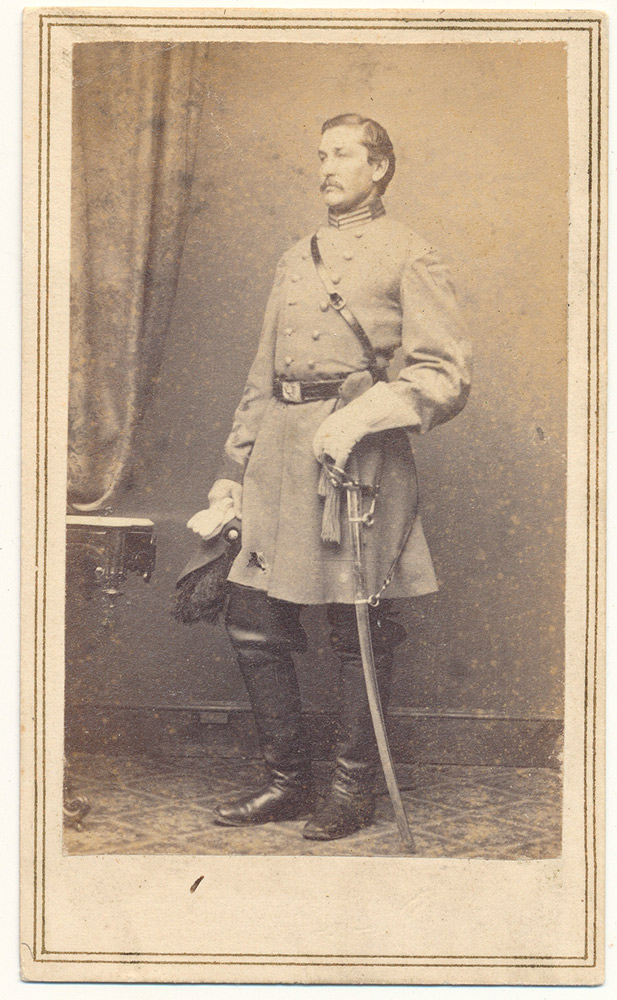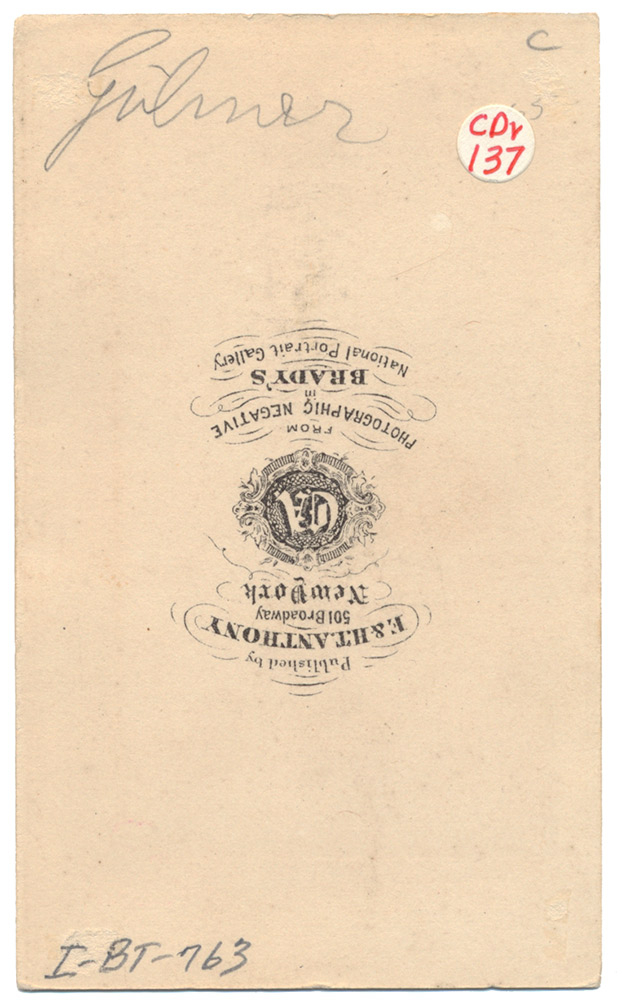site search
online catalog
CDV OF MARYLAND CONFEDERATE CAPTAIN HARRY W. GILMOR

Hover to zoom


$1,250.00 SOLD
Quantity Available: None
Item Code: 1138-763
Carte de visite photograph of Gilmor in uniform. Full standing studio view wearing double-breasted frock with captain's collar insignia, sash, sword belt, sword, and plumed hat in hand. Image is clear with very good contrast. Mount is clean. Misspelled pencil identification on back (Gilmer). Photographer's backmark, E. & H.T. Anthony, New York from Brady's negative.
Harry Ward Gilmor (January 24, 1838 – March 4, 1883) served as the Baltimore City Police Commissioner, head of the Baltimore City Police Department in the 1870s, but he was most noted as a daring and dashing Confederate cavalry officer during the Civil War. Gilmor's daring raids gained his partisans fame as "Gilmor's Raiders".
During the Civil War, as a member of the "Baltimore County Horse Guards" Gilmor was arrested and imprisoned in Fort McHenry following the "Pratt Street Riots" of April 19th, 1861. Upon his release, he traveled South and eventually rejoined the fighting serving under General Turner Ashby. He was again captured during the Maryland Campaign and spent five months in prison. During the Gettysburg Campaign of June–July, 1863, Major Gilmor was assigned command of the First Maryland Cavalry and Second Maryland Cavalry, supporting Brig. Gen. George Steuart's infantry brigade. Gilmor was the provost marshal of the town of Gettysburg while it was occupied by the Confederates on July 1–4.
As part of the third major Confederate invasion of the North, after the Battle of Monocacy, Gilmor's command made a series of raids around Baltimore. On July 10, 1864, he was given 135 men of the 1st and 2nd Maryland, and directed to cross northern Baltimore County to Jerusalem Mill, and destroy the railroad bridge of the Philadelphia, Wilmington, and Baltimore Railroad across the Gunpowder River. On the morning of July 11, Gilmor's cavalrymen reached the railroad and proceeded to stop two northbound trains from Baltimore. After evacuating the passengers, the troopers set fire to the second train and backed it down the tracks and onto the bridge. The train burned through the draw section of the bridge. This raid was regarded as one of the most daring during the war by detached cavalry on either side.
Gilmor was later ordered to take his command to Hardy County, West Virginia, and attack the Baltimore & Ohio Railroad. There, he was captured on February 4, 1865 and was held as a prisoner of war at Fort Warren in Boston Harbor until July 24, 1865.
After the war, Gilmor moved to New Orleans, where he married Miss Mentoria Nixon Strong. Gilmor and his wife had three children. Gilmor wrote his war memoirs, entitled "Four Years in the Saddle". He soon returned to Maryland and was elected a colonel of the cavalry in the reorganized Maryland National Guard. He also served as the Baltimore City Police Commissioner from 1874 to 1879.
Gilmor died in Baltimore, plagued by complications from a war injury to his jaw. He was buried in Loudon Park Cemetery in the southwest section of the city between Frederick Road and Wilkens Avenue, in an area of the cemetery now known as "Confederate Hill." [jet] [ph:L]
~~~~~~~~~~~~~~~~~~~~~~~~~~~~~~~~~~~
THIS ITEM, AS WITH ALL OTHER ITEMS AVAILABLE ON OUR WEB SITE,
MAY BE PURCHASED THROUGH OUR LAYAWAY PROGRAM.
CLICK HERE FOR OUR POLICIES AND TERMS.
THANK YOU!
Inquire About CDV OF MARYLAND CONFEDERATE CAPTAIN HARRY W. GILMOR
Most Popular
Historical Firearms Stolen From The National Civil War Museum In Harrisburg, Pa »
Theft From Gravesite Of Gen. John Reynolds »
Selection Of Unframed Prints By Don Troiani »
Fine Condition Brass Infantry Bugle Insignia »
Large English Bowie Knife With Sheath 1870’S – 1880’S »
Imported (Clauberg) Us Model 1860 Light Cavalry Officer's Saber »
featured item
VERY SCARCE CONFEDERATE SOUTH CAROLINA CARTRIDGE BOX BELT PLATE
A very attractive example of a scarce plate. O’Donnell and Campbell illustrate this pattern as #472 in their American Military Belt Plates, and Mullinax (1991) notes at least two different die strikes in their production, calling this one, with a… (1287-07). Learn More »


